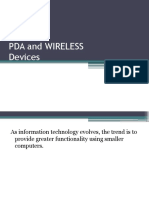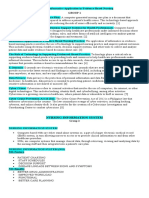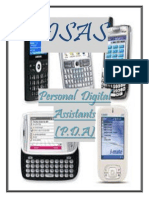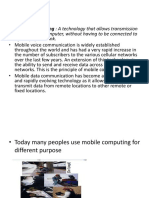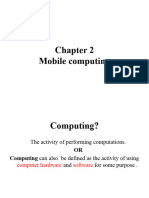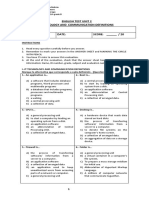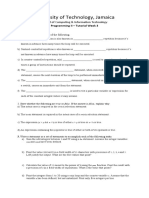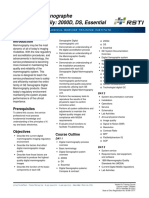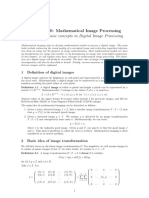Republic of the Philippines
PANGASINAN STATE UNIVERSITY
INSTITUTE OF NURSING
Bayambang, Pangasinan
S.Y. 2020-2021
Nursing Informatics
PERSONAL DIGITAL
ASSISTANT AND
WIRELESS DEVICES
SUBMITTED TO:
JOSHUA B. MATABANG
BSN 2-1
SUBMITTED TO:
DR.MA. BERENICE GLIZZLE M. CATABAY
CLINICAL INSTRUCTOR
� PERSONAL DIGITAL ASSISTANT (PDA)
Personal digital assistant is a term for a small, mobile, handheld device that provides
computing and information storage and retrieval capabilities for personal or business use, often
for keeping schedules, calendars and address book information handy.
Popular in the 1990s and early 2000s, personal digital assistants (PDAs) were the
precursors to smartphones. Most PDAs had a small physical keyboard, and some had an
electronically sensitive pad on which handwriting could be received. Original uses for a personal
digital assistant included schedule and address book storage and retrieval and note-entering.
However, many types of applications were written for PDAs.
Types of PDA devices
Apple's Newton was the first widely sold PDA that accepted handwriting. Other popular
PDA devices included Hewlett-Packard's Palmtop and Palm's PalmPilot. Some PDAs offered a
variation of the Microsoft Windows operating system called Windows CE. Other products had
their own or another operating system.
PALM OS UNIT
is a discontinued mobile operating system initially developed by Palm, Inc., for personal
digital assistants (PDAs) in 1996. Palm OS was designed for ease of use with a
touchscreen-based graphical user interface.
WINDOWS CE
is an operating system developed by Microsoft and designed for small footprint devices
or embedded systems.
�SYMBIAN OS PDAS
is a discontinued mobile operating system (OS) and computing platform designed for
smartphones. Symbian was used by many major mobile phone brands, like Samsung,
Motorola, Sony Ericsson, and above all by Nokia.
OTHER TYPES
• Tablet PCs
• Blackberry Devices
• Smart Watches and Pagers
• Cellular phones with PDA function
HISTORY OF PDAS
Apple CEO John Sculley coined the term PDA in 1992, but devices fitting that
description had existed for nearly a decade prior.
In the mid-1990s, the manufacturers of PDAs, pagers and cellular telephones began to
combine the functionality of those devices into a new device type now known as a smartphone.
Nokia, IBM and Palm were some of the major players in the market at the time.
PDA and pager manufacturer Research in Motion Limited released its
first BlackBerry smartphone in 2000, and the company dominated the market for most of the
century's first decade. In 2007, Apple released the first iPhone, a touchscreen smartphone, and
within five years the market had shifted away from devices with physical keyboards.
Future of PDAs
In the 2010s, the technology industry recycled the term "personal digital assistant." The
term now more commonly refers to software that recognizes a user's voice and uses artificial
�intelligence to respond to queries. Examples of this type of personal digital assistant include
Apple's Siri, Microsoft's Cortana and Amazon's Alexa.
Advantages of PDA:
Availability –
One of the primary preferences of possessing a PDA is the capacity to stay in contact with
individuals through email, text informing and telephone. Since PDAs are so convenient
and networks so broad, clients can take them anyplace.
Broad Internet Connectivity
For occupied people, the primary preferred position of getting a PDA is being able to
remain associated through email, calls, text informing and different courier applications.
These are worked with broad organization network so clients can get to the Internet
anyplace they are.
Disadvantages of PDA:
Cost –
One of the greatest hindrances of a PDA is the expense. Other than paying for the gadget
itself, most PDAs require the purchaser to buy in to a utilization contract. This includes a
month to month bill and the chance of overage charges if the client outperforms his
designated free telephone minutes or information limits.
Interruption
PDAs may likewise turn into an interruption when they’re not satisfying an authentic
need. The capacity to be constantly associated can prompt sat around riding the Web,
settling on telephone decisions or messing around. Some business clients whine of being
“available to come in to work” when their colleagues and bosses can reach them
whenever.
� WIRELESS DEVICES
Wireless Technology
Wireless technology describes electronic devices that communicate without cords using
radio frequency signals. Wireless technology is used in a variety of modern device to provide
convenience and greater mobility, and wireless devices play an important role in voice and
Internet communications.
Wireless Router
A wireless router is a device that accepts an incoming Internet connection and sends data
as RF signals to other wireless devices that are near the router. Wireless routers are used to
connect wireless-enabled computers and other devices to the Internet. A network set up with a
wireless router is sometimes called a wireless local area network (WLAN.). Many routers have
built-in security features such as firewalls which help protect devices connected to the router
against malicious data, such as computer viruses.
Wireless Adapters
Wireless adapters are hardware devices installed inside computers that enable wireless
connectivity. If a computer does not have a wireless adapter, it will not be able to connect to a
router in order to access the Internet. Some computers have wireless adapters built directly into
the motherboard while it is also possible to install stand-alone wireless adapters to add wireless
capability to a computer that did not come with an adapter built in.
�Wireless Repeater
A wireless repeater is a wireless networking device that is used to extend the range of a
router. A repeater receives wireless signals and then re-emits them with increased strength. By
placing a repeater between a router and the computer connected to the router, signal strength can
be boosted, resulting in faster connection speeds.
Wireless Phones
Cellular and cordless phones are two more examples of device that make use of wireless
signals. Cordless phones have a limited range, but cell phones typically have a much larger range
than local wireless networks, since cell phone providers use large telecommunication towers to
provide cell phone coverage.Satellite phones make use of signals from satellites to communicate,
similar to Global Positioning System (GSP) devices.
Other Devices
Anything that uses radio signals to communicate can be considered a wireless device.
Common devices, such as garage door openers, baby monitors, certain video game consoles and
walkie-talkies, make use of wireless technology.
REFERENCES:
https://searchmobilecomputing.techtarget.com/definition/personal-digital-
assistant#:~:text=Personal%20digital%20assistant%20is%20a,and%20address%20book
%20information%20handy.
https://www.techwalla.com/articles/what-are-different-types-of-wireless-devices
https://www.geeksforgeeks.org/advantages-and-disadvantages-of-personal-digital-assistant/








